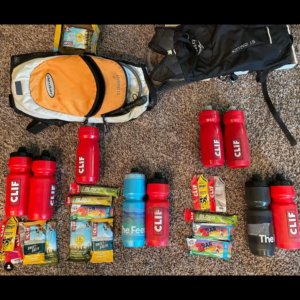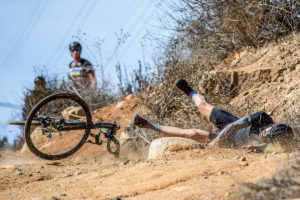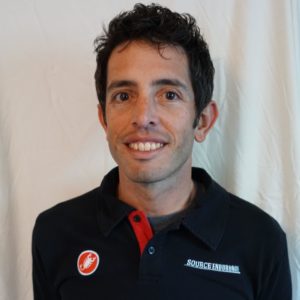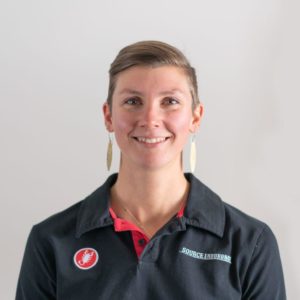How to Avoid DNFing the BWR

Many begin an epic adventure like the one you’ve just embarked upon expecting moderate discomfort and glory to await us, but only the most prepared will triumph over the Belgian Waffle Ride. Although the numbers are not public, we know a high percentage of riders never cross the finish line and get their own ride home. What looks like a difficult but manageable day can quickly go sideways for athletes that haven’t experienced the diabolical nature of the Belgian Waffle Ride. With proper preparation and following these tips you will make sure you are not one of those DNFers!

Physical Preparation
The Belgian Waffle Ride has undergone an evolution that makes even the Wafer one of the hardest events in North America. The Waffle is even more difficult and grueling. Completing the Waffle now requires commitment to fitness and training as part of your daily lifestyle. In order to bring your performance “A Game” to the start line preparation should begin early and in earnest and the best training plans begin months in advance (very much analogous to a full Ironman). We would advise that an average “weekend warrior” will not have fun on the Waffle.
Preparation is key for success and Source Endurance has a number of tools to help you with this aspect including a FREE Training Guide, Training Plans and fully custom Concierge Coaching. But don’t worry, we know that procrastination is a learned skill and we have Training Plans for that too! If you’re ready to go all-in then join us for our BWR Survival Camps. Campers boast a >95% success rate on game day and it’s a great way to compliment your BWR experience.
Expected Arrival Time and Speed
Calculate your expected average speed for the day, including stoppage time. You’ve probably done a fair bit of training to prepare for this fantastic day of adventure. Having an expected finishing time will help you to keep perspective and manage expectations. Here’s a simple calculation you can use for your 3 longest rides in the last 6 weeks to help you project your finishing time: Record start and finish time of day, then calculate the difference. Divide total distance covered by time to get real average speed.
At the Source Endurance training camps we find that 10 mph average speed is about right for most with a “quick” day being 13-15 mph. Use this calculation to decide if you have chosen the proper event and if should begin your day with lights on the bike. ~15% of the BWR CA finishers were after sundown which is a scary proposition in a major city.
Let’s talk more about Stoppage Time…
Stopping Too Long at Rest Stops
The legs may be depleted, the brain foggy and the spirit ready to take a break, but these are not reasons to stop riding your bike. Strive to be as efficient as possible when stopping to replenish food and hydration at the aid stations. This time off the bike can quickly accumulate and leave you with little margin for error to finish the day during daylight hours and/or without being time cut. Plan for what you will grab at each aid station before you get there and take as little time as possible. It’s a good idea to never sit down and keep the stops to 5 minutes or less. Every minute you are stopped is a minute you’re not getting down the road and the clock is ticking.

More about Rest Stop/ Aid Station Protocol
Proper preparation for these events centers around controlling what variables you can and the food you eat during the event is definitely something that is controllable. Ideally, your Race Day Nutrition Plan will dictate all the food you’ll carry for the day which eliminates the chance of eating something “disagreeable” that leads to gastro-intestinal problems. Many elite and professional athletes make it a point to show us what they carry on race day. This image is from Pete Stetina at Unbound Gravel in 2021. The best part about carrying your own food is that your tummy is being treated to only your favorite foods!
When you’re at the Aid Stations, PLEASE TAKE ONLY WHAT YOU’RE GOING TO EAT THAT DAY. The events only plan for people to eat what they take and will not have enough supplies for you to stuff your pockets full of gels for that next event in 6 weeks. Be mindful of food and water needs for the hundreds of people behind you including the last rider. Someday that might be you.
General Bike Maintenance
After pacing and stoppage time, this is arguably the number one reason people DNF. General guidelines include not touching anything with a tool on your bike a few days (especially the night before) before game day. If it works today, it will work tomorrow. It can be tempting to want to make last minute adjustments and dial in your rig for the big day, but it increases the chance of something going unexpectedly wrong. Consider going to your local bike shop 2 weeks out from Belgian Waffle Ride to have them look over your rig and make sure it doesn’t need any new parts or adjustments. Common parts on the bike that need to be replaced include: chain, cables and housing, brake pads, and tires. Common adjustments which need to be made include derailleurs, brake bleeds, truing of wheels, and tightening of bolts. The rugged terrain and variable conditions can loosen bolts you never knew would come undone.
Catastrophic Mechanicals
Although there are times when flat tires cannot be avoided, there are equally as many times as they can. First, run tubeless tires because they perform better and allow you the peace of mind. Next, make sure to have a hefty amount of sealant in each tire to prevent little holes from sabotaging your finishing time. We recommend 3oz of sealant per tire. Add this sealant within 1-1.5weeks of starting the event. If you added the sealant 3 weeks ago and rode a few hundred miles, chances are that sealant has already been put to work sealing holes in your tire. We recommend bringing these essentials in your saddle bag. Make sure to bring tire boots and tire plugs in case of larger punctures like side wall slashes or nails and other sharp objects. If you don’t know how to use tire boots and plugs, make sure to practice on a tire before trying your hand at it on the road. Line choice is arguably the number one reason riders finish the day early with multiple flats feeling frustrated and deflated, pun intended. Be conscious when descending the dirt and gravel sections to avoid big and sharp rocks as much as possible as well as anything green (goat heads are a common spikey plant also known as “puncture vine”). If you can avoid it, avoid it. Avoid glass or other sharp and pointy objects on the roads as well. Be conscious of sharp objects and obstacles on the road.

Less than Ideal Pacing
There are those of us who want to ride like heroes early and often and to those individuals we would say, finishing is still goal number one. Know your limits on race day and go into the ride with a pacing strategy. If you attempt to ride with the front group and burn out in the first 50 miles, the last +50 miles are not going to be as fun and you may not even see those miles. Inadequate pacing can also contribute to the higher chance of inadequate fueling and getting behind on fluid and calories, stopping too long at rest stops because you are tired, crashing due to the brain fog from being in the red, and generally just going too slow at the tail-end of the ride to finish on time. If you’re curios about what pacing is best for you we can help with that too.
Crashing
Without getting too into it, let’s just admit that this is mostly an avoidable thing and to weigh risk with reward before sending it too hard.

These tips may seem obvious and intuitive, but they should not be undervalued. Belgian Waffle Ride has a high rate for riders not finishing, and most of those excuses for not finishing can be avoided with proper preparation and mindset.
By:

About the Author:
Adam Mills has raced at the elite level since 2002 and graduated with a Masters Degree in Exercise Physiology from the University of Kansas in 2005. His true talent comes with his ability to combine his vast experience with his knowledge of sport. He is indeed a student of science, sport, athletic performance, strategy, and tactics. He continuously educates himself by keeping up to date with current research trends and methods in sport and his clients have reaped the benefits from this work with over 22 national championships in 11 disciplines on two continents. Adam is able to incorporate these attributes on a daily basis to help his clients reach and exceed their goals whether they are a beginner or a seasoned professional.

About the Author:
Kristen Arnold MS, RDN, CSSD is a level 2 USA Cycling coach as well as a Registered Dietitian (RD) specializing in sports nutrition and is a board Certified Specialist in Sports Dietetics (CSSD). With Kristen’s nutrition expertise and diverse experience in the sport of cycling as a racer and a mentor, she provides a comprehensive approach to her coaching. She works with athletes from the beginner to elite ranks in road, cyclocross, and mountain biking disciplines. Kristen is professional road racer racing with Wolfpack Women's Racing, and seasoned mountain bike and cyclocross racer.
